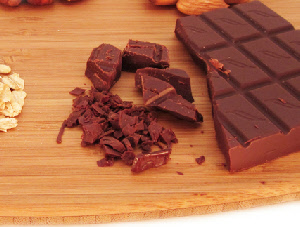
This combination of compounds active for our brain confers to chocolate its reputation of antidepressant food.
In addition to its antidepressant and brain stimulant effects, cocoa also has strong antioxidant properties which can be attributed to the presence of polyphenoles, the same antioxidants found in red wine. As a matter of fact, with a staggering 10% content in flavonoids, cocoa tops other antioxidant rich foods for its abundance of polyphenoles. Antioxidants act by blocking reactions of chemical degradation called "oxidations" which are associated to cancers, aging and in general, damages to our genetic material.
So, we have a staggering amount of research stressing the nutritional benefits of cocoa and chocolate. But is all information about chocolate just good news?
There are other factors to consider. To begin with, chocolate has a high fat content.
In particular chocolate contains saturated fats. Fats, as we know, can be divided
in two categories: fats that are recognized to be unhealthy, such as saturated fat,
trans-
Some of the saturated fats in chocolate come from cocoa itself, but the great majority of it is added to the chocolate during the manufacturing process. Although cholesterol derives almost exclusively from animal sources, some chocolate products may also contain cholesterol as they are combined with milk.
Saturated fats are added to processed cocoa to provide the solid consistency and
reach the desired melting point. For a certain number of years, several brands prepared
chocolate using hydrogenated fat; a vegetable oil which has been chemically altered
to be solid. The use of this fat was justified to increase the shelf stability of
the product. This form of fat, also known as trans-
Good for the brain, easy on the palate
The nutritional benefits of eating cocoa
For a good majority of people, a craving for sweets means only one thing…chocolate!
This has been true for centuries. Not surprisingly, the biological name of the tree
that produces the precious seeds from which cocoa is extracted is called Theobroma
cacao, which translated from Greek literally means "food of the gods". In addition
to the intriguing bitter-
The culinary qualities of chocolate come with great nutritional value as well. It
has been known for a long time that cocoa contains hundreds of chemicals among which
there are compounds suggested to stimulate the brain with antidepressant and anti-
The most common ingredient, from which cocoa takes its name, is theobromine, which
is abundant in cocoa in amounts up to 3% (1g of pure cocoa delivers an average of
20mg of theobromine). Theobromine is chemically very similar to caffeine, and is
known to have pharmacological stimulating properties for the central nervous system,
it acts as vasodilator and heart stimulant, and it has diuretic properties. In spite
of its similarity to caffeine, theobromine has a weaker effect, and it is less addictive.
Recent studies also suggest that theobromine could be used as anticancer agent and
cough-
A second psychoactive compound present in cocoa is phenylethylamine, an alkaloid similar to dopamine and epinephrine produced in the body. This class of compounds is known to have antidepressant and stimulant effects. The interesting effect of phenylethylamine is its ability to stimulate alertness.
In addition to theobromine and phenethylamine, cocoa also contains traces of anandamide, frequently called the "bliss molecule". This chemical belongs to the family of cannabinoids: the active compounds in marijuana (Cannabis sativa). Anandamide binds cannabinoid receptors mimicking the activity of this drug. Although the amount of this neurotransmitter in cocoa is too low to exert a feasible effect, studies suggest that other chemicals in cocoa reduce the degradation of anandamide prolonging its effect.

Your diet customized with one click!
One
Click
Diet
One
Click
Diet

Copyright © 2010 OneClickDiet.com All right reserved.
No part of this web-
Disclaimer: The information provided on this site is for informational purposes only and is not a substitute for medical or nutritional advice, or treatment for any medical conditions. You should consult a healthcare professional or nutritionist before starting any diet, exercise or supplementation program, or if you have or suspect you might have a health problem. Actual results from nutritional plans and diets as well as exercise activities usually vary among individuals. The products and the claims made about specific products on or through this site have not been evaluated by the United States Food and Drug Administration (US F.D.A.) and are not intended to diagnose, treat, cure or prevent any disease. You should not use the information on this site for diagnosis or treatment of any health problem or for prescription of any medication or other treatment. Please view our full "Terms Of Use" for more information and the terms and conditions governing your use of this site.
Home
About
Contact us
